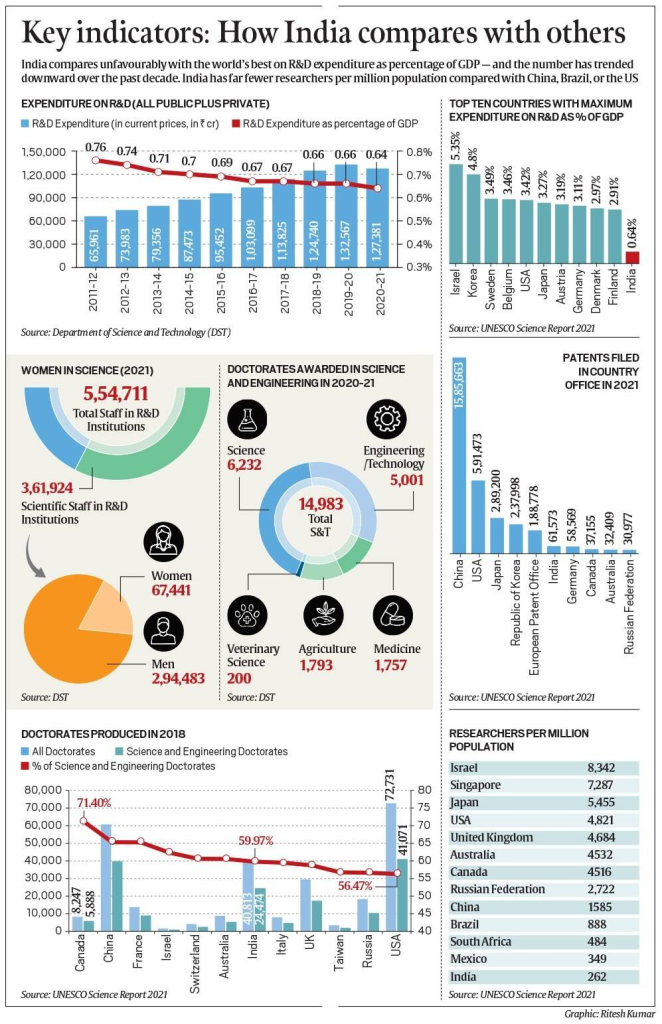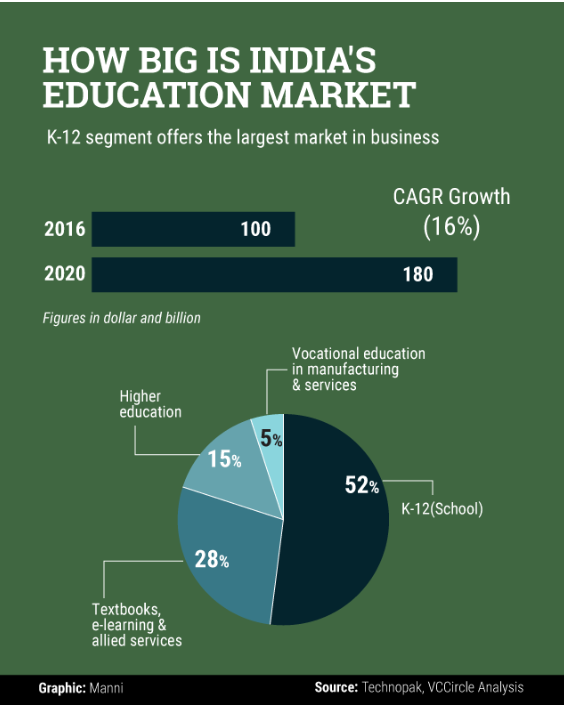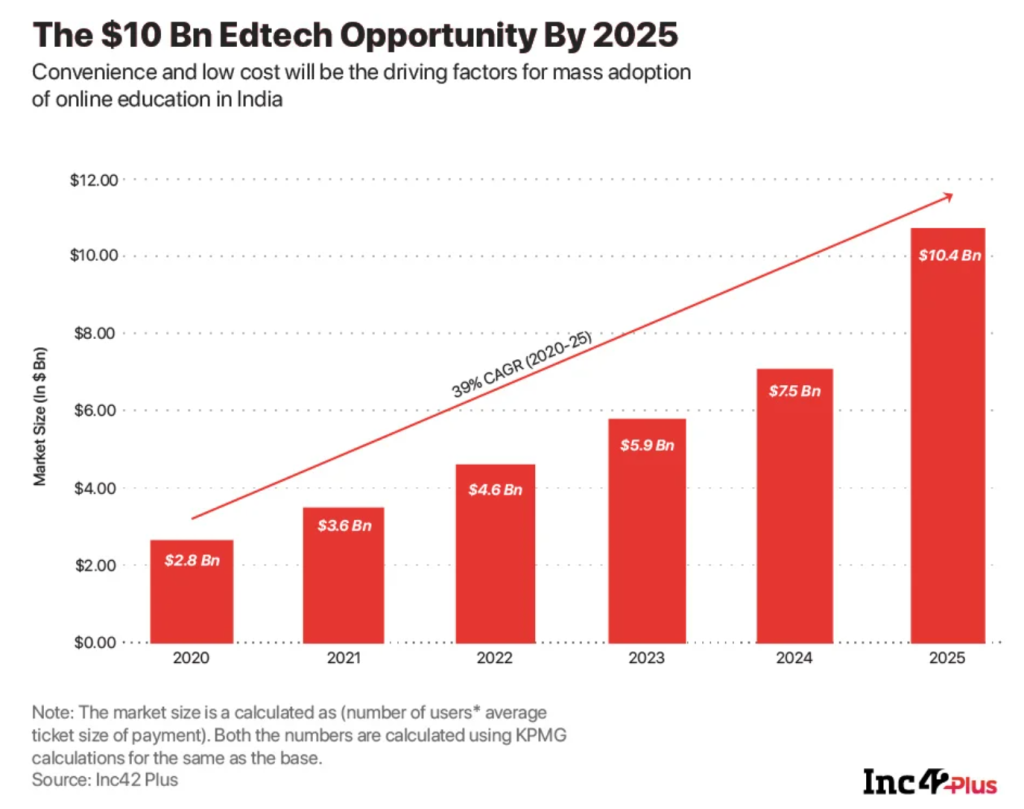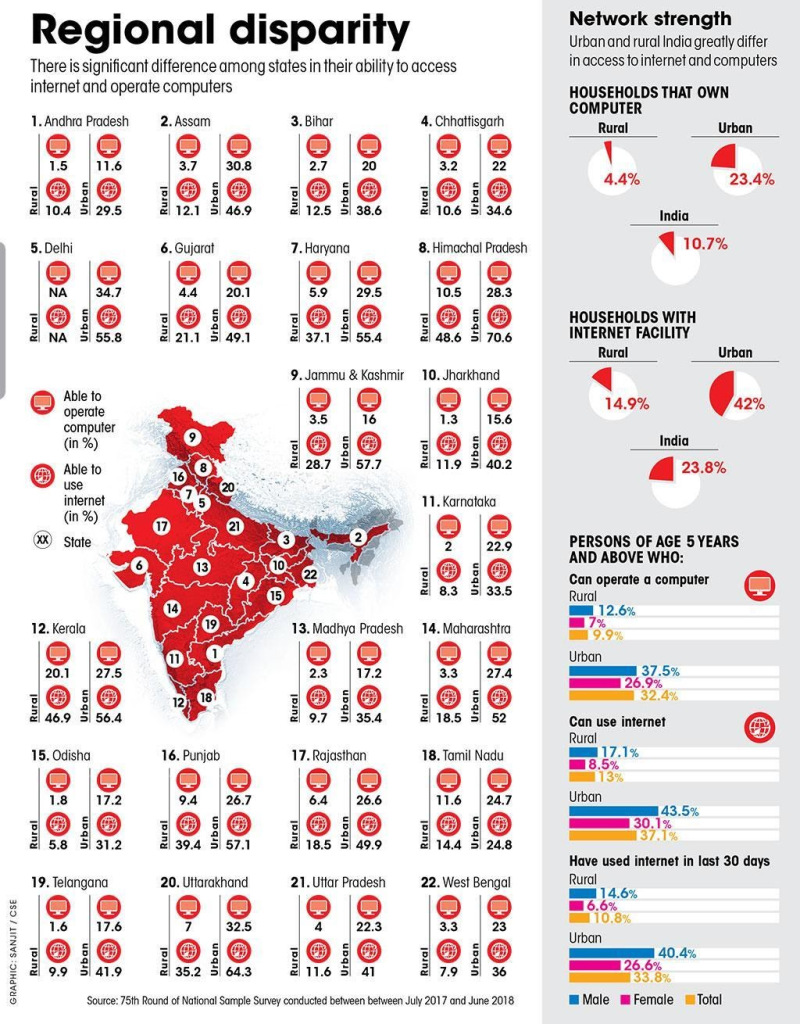CONTENTS
- Prioritising Scientific Research in India
- Transformative Trends in India’s Higher Education
Prioritising Scientific Research in India
Context:
With nearly a billion Indians engaging in the ongoing general election process, what are the priorities for scientists? Whom do they endorse, and what key issues do they hope their elected officials will address and enact? Scientists and other science enthusiasts (as seen in this article) advocate for attention to five core issues by the new government and urge elected representatives to prioritize them.
Relevance:
GS-2- Government Policies & Interventions
GS-3
- Indigenization of Technology
- IT and Computers
- Space Technology
- Robotics
- Artificial Intelligence
Mains Question:
Despite their relatively small numbers, scientists constitute a significant electoral constituency, capable of influencing policymaking for the greater public good. In this context, discuss the issues that need to be prioritized by the government for the benefit of the science enthusiasts and scientists. (15 Marks, 250 Words).
Five Core Issues:
Boosting Investment:
- Initially, there’s a call for an increase in the nation’s spending on research and development, which currently stands at less than 0.7% of GDP. Both government funding and contributions from private entities, which currently make up less than 40% of total spending, need augmentation.
- It is suggested that government spending should rise by at least 50% annually over the next five years, aiming to reach nearly 4% of GDP by the end of the new government’s term.
- Encouraging the private sector to invest more in research and development is vital. One avenue for this is through participation in the recently formed Anusandhan National Research Foundation (ANRF), where the private sector is anticipated to contribute ₹36,000 crore over a five-year period.
- The augmentation of funding necessitates the cultivation of a skilled scientific workforce capable of utilizing these resources prudently and punctually, which includes both the recruitment of new talent and the support of existing human resources.

Enhancement of the Infrastructure:
- Secondly, there is an urgent need to enhance the physical and intellectual infrastructure of public sector institutions, such as universities and research centers.
- The modernization of science laboratories across undergraduate colleges, state and central universities, and specialized research institutions is imperative.
- Upgrading infrastructure entails not only the recruitment of more qualified educators and researchers to fill existing vacancies but also effectively doubling their numbers over the next five years.
Emphasis on Merit:
- Thirdly, there is a need to reform the hiring processes within educational and research institutions to align with globally recognized standards that prioritize transparency, efficiency, and freedom from external influence.
- Selection criteria should strictly adhere to merit-based principles, with competent committees tasked with selecting candidates solely based on their qualifications and capabilities, devoid of any external pressures.
- The aim is to ensure that the time between application submission and the issuance of appointment letters does not exceed six months. Established global norms for hiring quality educators and scientists should serve as our guide.
Establishment of a Robust System of Management:
- Fourthly, establishing a robust system for managing science grants is essential to facilitate research endeavors.
- This system should minimize bureaucratic hurdles in grant submissions, expedite the disbursement of grants and student fellowships, eliminate the need for hard-copy submissions, and grant autonomy to individual scientists regarding their research expenditures.
- Efficient allocation of funds among scientists necessitates granting flexibility in procurement beyond the government’s mandated e-marketplace.
- Currently, scientists are constrained to procure from this platform, which sometimes leads to the purchase of lower quality “Made in India” products due to their lower prices.
- Providing scientists with the freedom to purchase based on their research needs rather than solely focusing on the cheapest available products is crucial for effective spending.
Ensuring Academic Freedom:
- Finally, scientists advocate for the fundamental freedom to express their views and publish research based on evidence without external interference. A thriving startup ecosystem in academia is vital for fostering innovation that benefits society at large.
- While previous administrations have taken steps to promote innovation and entrepreneurship on Indian campuses, true innovation will flourish when the government grants full autonomy to individual scientists.
Conclusion:
To realize India’s ambition of becoming the world’s second-largest economy by 2050, the new government must streamline the process of conducting scientific research and grant scientists the autonomy to ideate and execute without undue bureaucratic obstacles and paperwork. While encouraging researchers to generate wealth and employment through innovation and entrepreneurship, it’s crucial for the government to prioritize investment in fundamental scientific research and knowledge creation. These two aspects are interdependent; one cannot thrive without the other.
Transformative Trends in India’s Higher Education
Context:
India’s higher education sector is experiencing a profound transformation driven by initiatives such as the New Education Policy (NEP) 2020, skill development programs facilitated by the National Skill Development Corporation (NSDC), and the promotion of 100 percent Foreign Direct Investment (FDI) in the education sector. These efforts have created a fertile ground for innovation and investment.
Relevance:
GS2- Education
Mains Question:
The surge in EdTech presents opportunities for democratising education but also highlights challenges such as the digital divide and ensuring quality. Analyse. (10 Marks, 150 Words).
Other Significant Initiatives:
Initiatives like the University Grants Commission’s (UGC) push for establishing international campuses within India and the Ministry of Education’s emphasis on global learning are reshaping the educational landscape.
India’s Higher Education System:
- The market size of India’s higher education system reached an estimated $40 billion in 2023, demonstrating a Compound Annual Growth Rate (CAGR) of 15 percent.
- With a vast network comprising over 1,200 universities, 49,400 colleges, and 12,600 standalone institutions, India boasts one of the largest higher education ecosystems globally.
- These institutions serve more than 50 million students, a number projected to increase substantially in the coming years.
- They play a critical role in achieving higher Gross Enrolment Ratios and enhancing the skill sets of the future workforce.

Digital Learning Methodologies:
- Amidst this expansion, the post-pandemic era has witnessed a significant surge in the adoption of digital learning methodologies.
- Universities are offering online programs, while various platforms provide a diverse range of courses online.
- Given the existing infrastructure and anticipated demand, it is imperative for India to explore and capitalize on the opportunities presented by online learning and skill development.
- Aligning these opportunities with the country’s next 10-year growth plan is essential for equipping the workforce with the necessary skills to enhance graduate employability in a rapidly evolving job market.
Inclination Towards Interdisciplinary Programs:
- However, there has been a notable shift in the course preferences among students in recent years. India is transitioning away from traditional fields like engineering, medicine, and management.
- Nowadays, students are increasingly inclined towards interdisciplinary programs and contemporary courses that offer quicker skill acquisition and certification.
- This trend presents a significant opportunity for educational institutions to broaden their offerings by introducing certification and degree programs tailored to these emerging fields, enabling students to acquire new skills in shorter durations.
The rise of Educational Technology (EdTech):
- The rise of Educational Technology (EdTech) has been transformative and presents a promising area for investment and innovation. These platforms offer a wide range of services, including career guidance and student counseling, in a digital format.
- By doing so, they have democratized access to education, ensuring that students from all corners of the country have access to better career opportunities.

Way Forward:
Bridging the Digital Divide:
- Improving internet connectivity and making technology more accessible are essential steps in ensuring that all students can benefit from online educational resources.

- Additionally, as the landscape of higher education continues to evolve rapidly, there is a need to strengthen quality assurance mechanisms and adapt accreditation and regulatory frameworks accordingly.
Adapting Regulatory Bodies:
- These bodies must remain agile and responsive to the changing dynamics of higher education to uphold academic integrity and ensure positive student outcomes.
- By adapting to these changes and maintaining high standards, regulatory bodies can play a crucial role in safeguarding the credibility and relevance of higher education in India.
Internationalization of Higher Education:
- The Ministry of Education’s present emphasis on the internationalization of higher education in India is poised to yield far-reaching impacts, extending beyond educational norms to influence the broader economy and societal fabric.
- This strategic orientation towards internationalization opens avenues for transnational education initiatives and facilitates the exchange of students and faculty across borders.
- Consequently, it contributes to the cultivation of a globally competitive workforce and promotes the exchange of knowledge and expertise among nations.
Smart Scaling:
- Looking towards the future, the trajectory of higher education in India transcends mere expansion; it encompasses the concept of smart scaling. This entails not only scaling up in terms of quantity but also scaling up in terms of quality and innovation.
- By embracing emerging trends and proactively addressing inherent challenges, we can ensure that the higher education sector in India evolves into a dynamic ecosystem that not only grows but also thrives.
- This entails providing every student with access to a world-class education and equipping them with the skills and opportunities to compete on a global stage.
Internationalization of Higher Education:
- Furthermore, the internationalization of higher education presents opportunities for Indian institutions to establish collaborations and partnerships with esteemed universities and research institutions worldwide.
- These collaborations can foster joint research initiatives, facilitate technology transfer, and promote cultural exchange, thereby enriching the academic landscape and fostering a spirit of global citizenship among students.
Conclusion:
In essence, the Ministry of Education’s strategic focus on internationalization heralds a new era of innovation, collaboration, and global engagement within the Indian higher education sector. By leveraging these opportunities and navigating challenges effectively, India can position itself as a hub of excellence in higher education, contributing significantly to national development and global advancement.





